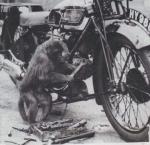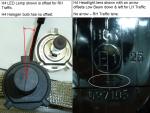-
Posts
988 -
Joined
-
Last visited
-
Days Won
43
Content Type
Profiles
Forums
Events
Gallery
Community Map
Everything posted by MartyNZ
-
I think you could be overstating things. Cash1000 has seen my shed. See pic We may just drink beer, and hope the little guy knows what he is doing. We don’t want to look as if we’re trying too hard, just in case someone is watching.
-
Nigel, If you can make the trip into town interesting enough that you don't die of boredom on the way, you could visit next weekend and we could try a few things that were suggested. I have meters to measure horn current and earth resistance, enough spare relays to troubleshoot, and enough grease, goo, and goop for a lifetime. KiwiRoy's relay base repair fixed an intermittent snag on my bike, so we can check that. I have beer too. PM me. Marty
-

Happy New Year 2017-> 2018
MartyNZ replied to docc's topic in Special place for banter and conversation
Yes, happy 2018 Docc & everyone. Just to provide a global perspective, us southern hemisphere Guzzi owners are enjoying a great summer. Not everyone on the planet is miserably cold at the moment. The photo is of a little care and feeding for my V11, using the new maintenance stand I finally got around to making. Having the bike sit level overnight on this stand means that I can check the, engine, gearbox & transmission oil levels accurately. Shockproof Heavy is too thick to show the level on the gearbox sight glass when I hold the bike up off the sidestand. Usually I got tired of waiting, and added oil. The gearbox oil "leak" disappeared when I drained the oil level down to the middle of the sight glass after settling overnight. The bevel box was a little overfull too. Just removing the level plug after sitting on the stand overnight drained off a little excess oil. -
I plan to cut the rear driveshaft spline "pinch slot" a little deeper, next time I have it apart, so there is better clamping onto the bevel box input spline. Mine has a tiny amount of free play that I think might lead to spline wear.
-
One thing that is difficult to design against is vibrations. Could the spring buzz itself to death? Are there any wear marks where the spring sits in the shifter mechanism? If, for example the spring resonates at 4000rpm, then the fatigue cycle count could get into very high numbers without much shifting. Changing the resonance frequency could make a steel spring last forever if the design stresses were below the fatigue limit. A resonance change could come from different thickness wire, different length spring, different oil in gbox. Just a thought. I know it doesn't help your design, but it may explain why you can't break that spring by shift cycles alone.
-
...and me too! I'll buy two. I expect someone over here could use one, and I'll use the other. For interest, I had two broken shift springs examined under a microscope by an expert. He said both springs broke at defects in the wire, one at a rust pit, the other at a gouge from something like pliers or clamping jaws. So a marginal original spring design, plus a defect in the wire, can equal a slow trip home.
-
Nigel, I may be able to clobber something up, but I'd need your chin pad for a few days, sometime after 12 November. When you say "a lot flatter", do you want it completely flat (easiest to make) or do you want some curvature? You would have to paint it yourself. Would aluminum alloy be okay, or do you need steel for magnetic attachment? If steel, then it should be cadmium plated before painting if you want durability, but this adds costs.
-
My bike is set to 0.25mm (0.010") on both in & ex, and it is awesome.
-
Never mind, I saw the red seat with Öhlins and got excited... Yes, it looks a bit like a Scura R, but has Marzocchi forks. That red seat is kangaroo hide. The owner is an upholsterer, and he made an excellent job of covering the seat. It looks great. Which bike is that? Can you copy/paste an image? Sorry Docc, I couldn't find a way to paste the pics, but links are below instead. Maybe Jaap's new security settings changed pasting? https://drive.google.com/file/d/0BxnfKnNo4vVwMjFsYlJmS0FHVjg/view?usp=sharing https://drive.google.com/file/d/0BxnfKnNo4vVwR2V3cWlSemQ2b1E/view?usp=sharing
-
Never mind, I saw the red seat with Öhlins and got excited... Yes, it looks a bit like a Scura R, but has Marzocchi forks. That red seat is kangaroo hide. The owner is an upholsterer, and he made an excellent job of covering the seat. It looks great.
-
I didn't notice a Scura, but could be wrong. DD had his Nero Corsa there, doing dangerous things. He set off first from Hilltop towards Akaroa, so I thought "I'll follow him". But at the first downhill, off camber, blind corner, where he passed two cars, I thought "No I won't". That guy made it look so easy.
-
Yeah, there were two Magnis there. One built on a Daytona engine with lots of goodies added, the other built with an 1100i engine/gearbox, but both had that clever parallelogram swingarm. That yellow moto batt battery on the 1100i Magni did stand out alright, and I thought it distracted from the good looks of the rest of the bike, but I'm sure he knows that. As for the rally name, I think it was originally called Rattley Tappet, but I don't know what why the change. Perhaps the Griso riders felt excluded?
-
About 70 people showed up for the 24th Tattley Rappet 2017 Moto Guzzi rally. There was a few V11s, some newer Guzzis, and a lot of older Guzzis. I set off for the first meeting on Friday evening, stalled on the way, and no restart! Relay failure! Just as well I had five spares stashed in the monkey paw trap. (Thanks Docc). We went over the hill to Akaroa on a Poker Run on Saturday, and we went to Kaikoura on Sunday. I got passed several times on the twisties by guys on round barrel Le Mans bikes. Even a scruffy Convert with a 1000 LeMans engine was no slouch. Those things are awesome, or is it the riders? Some of us went north past Kaikoura, on as far as the road is still open. It was closed by slips after a quake a year ago, but should be open again by the end of the year. On the way home I stopped at Parnassus to get fuel. It was an unattended fuel stop, but it took ages to get fuel. 15 minutes talking to a local guy, then fuelled up, then there was another quake, or was it an aftershock? (5.8 is enough to get your attention). There was a cop with a radar just down the road, and he drove up to me and he said "didja feel that? I'm not staying parked under those power lines with that kind of carry on". He was a motorbike cop in Christchurch in his early years, but he was polite enough not to say anything about my bike. So that took another 15 minutes swapping stories with him before I got going again. Good weather, great people, excellent weekend. Apparently the next Tattley Rappet will be in Palmerston North in 2018. Pictures of bikes here: https://drive.google.com/drive/folders/0BxnfKnNo4vVwWmZkNkNaam5Pdmc?usp=sharing Look out for the little Stornello there. The owner just finished restoring it, and rode furtherest to get to the rally. If the pictures don't open for you, please PM me and I'll try posting another way.
-
As Scud says, there is an escape hole in the grease cavity on every driveshaft. Normally the drive shaft length extends and compresses a little during suspension travel. This is the reason that the sliding spline exists, and it needs lubrication. I can think of two reasons why you need that little hole. 1. If the grease cavity was full of grease without an escape path, then it is possible to get a "hydraulic lock", which would make something bend or break at the next bump on the road. (at a guess, I'd say the gearbox top mount). 2. Grease is mostly oil mixed with a thickener, so as the oil seeps away, the remaining thickener needs to be flushed away by fresh grease. That little hole allows that flushing to happen.
-
Yes, the dipped/low headlight beam is directed down and left in NZ, Australia, Japan, Southern Africa, UK. Most European & American countries have the low beam offset to the right. In an H4 headlight with an incandescent/halogen bulb, this low beam deflection is done by the headlight lens. Other than pointing the headlight beam at a wall, the only way to tell if an H4 light is for LH or RH traffic is to look for the little arrow molded into the lens. If you have the arrow, you are good for LH traffic in Scotland. At least you are good until brexit kicks in, and Scotland secedes to join the EU. Then you will have to get serious about the metric system. Don't throw away your km speedo. Just because the British invented wonderful units of measure like Hogsheads per fortnight for fuel flow, it is not a good reason for Scotland to keep using it. . Some LED lamps also have some offset built into them. I needed to "adjust" the H4 adapter that came with a Chinese LED lamp to fix the weird low beam pattern that only suited RH traffic. The combination of RH lamp & LH lens made a slanted mess instead of a beam.
-
Lorenzoni says: GU98082445 VITE TE M8x45 http://shop.lorenzoni.it/prodotto.php?id=85&page=25
-
There are still a few of those head guards available in Australia. Here is picture of Joe Kenny's "standard with holes" head guard I got for my bike. There are a few left of other versions in Motociclo in Sydney. Link below. http://www.motociclo.com.au/products/product-type/general-service/general-accessories/crash-barsengine-protect Apparently they bought the last of Joe Kenny's stock. Their website is a bit average, but if you message me, I may be able to help you get some.
-
I know exactly how you feel. If you want to repair the can, there is a really helpful guide here: http://www.v11lemans...524#entry146073 The pictures are a victim of photo bucket price gouging, but the words may be enough. Drill out the end cap rivets at both ends, cut the silicon adhesive securing the glass wool, slip the skin of the can over a 100mm dia pipe or bar, and gently fettle back into shape. Easy.
-

Gratuitous Pics of Girls + Guzzi
MartyNZ replied to sign216's topic in Special place for banter and conversation
Some lovely pictures that Grant Vinten collected here. Girls and Bikes. http://v2guzzi.blogspot.co.nz/ -
-
A bit more information about this bike. Michael Noonan, who built it, says it's a 1982 Moto Guzzi V35, fitted with among other things, a Subaru supercharger. The supercharger is from a Subaru Vivio (660 cc), and is a Roots type Aisin AMR300 running 24 psi boost pressure. The speed record class is MPS PBG 350 (Modified Partial Streamlining / Pushrod Supercharged Gasoline / 350 cc). In the facebook video link below he claims 119.9 MPH (193 kph) average speed from a pass each way. Not too shabby for a V35! http://wildguzzi.com/forum/index.php?topic=87430.0 https://www.facebook.com/groups/327216784009013/permalink/1566551096742236/
-
The 24th Tattley Rappet Moto Guzzi rally is on over the long weekend 20-23 Oct 2017. This year it is in Kiapoi, near Christchurch, New Zealand. I know at least 2 local V11s will be there. And me.
-
If you want to remove and clean the injectors, here are a couple of references. Those injector retaining screws can be very tight though.http://www.v11lemans.com/forums/index.php?showtopic=19795 http://www.v11lemans.com/forums/index.php?showtopic=18805&page=17&do=findComment&comment=215317 http://www.v11lemans.com/forums/index.php?showtopic=19766
-
Any grease is much better than no grease, and that Lucas grease seems like good stuff. The grease can't come back out of the grease nipples, as there is a tiny ball & spring inside the nipple to stop that happening. Before greasing, you should wipe the nipples clear of road grime to avoid driving grit inside along with the grease. I pump enough grease into the joints so that you can see clean fresh grease oozing past the seals of all four cups. This flushes out old dried grease, moisture, and wear debris. However my method means a tedious wiping job to clean out all the surplus grease that would otherwise fling off and make a mess. The spline in the middle of the shaft doesn't need so much grease, as you can't flush the spline with new grease, it just comes out the end of the shaft (and makes more mess). The front joint is a bit tricky to get a grease gun onto. See http://www.v11lemans.com/forums/index.php?showtopic=18602for advice on how to swear.







